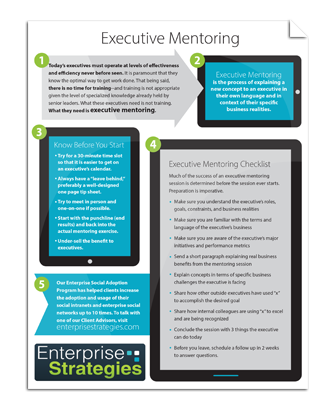I had lunch the other day with a colleague and former client at a Times Square restaurant that I must’ve walked by a hundred times, but never entered. Given its location in the heart of New York City, I thought it was a spot that catered to tourists, but as soon as I walked in, I knew I was wrong. The place had an old New York feel, a well stocked bar, attentive staff and was crowded with business types; it was exactly my kind of restaurant.
As my colleague and I caught up on the status of the social intranet we helped her launch last year, it occurred to me that my perception of the restaurant was not much different than my theory on executives and enterprise social networks: you have to experience them firsthand to get their real value.
I often speak to groups about how critical it is to the success of an internal social network to get senior leaders across the organization to use the network, not just support the idea of social. We’ve all seen surveys of executives who claim that social media is vital to their business, but how many believe that it requires their own participation in social?
As the leaders report demonstrates, using social can be helpful especially in looking at your competitors structures and their best leaders (hint: LinkedIn).
Social in the C-Suite
As we spoke at lunch, I inquired about some of the C-Suite execs I met with last year in an effort to jump-start their participation on social. Not only did it appear that all were still actively engaging their organizations, but the ripple effect was obvious, too.
First there was the senior sales leader who decided his interactions on the social intranet would be mostly congratulating colleagues who closed big deals. Soon, much of the sales staff were engaged on the site as they were competing for the chance to be “@mentioned” on the network and to receive kudos directly from the head of sales.
Next there was the regional leader who had been struggling to connect his direct reports scattered over a dozen countries. He was a complete social media beginner, but he saw the value inherent in a social network to engage his directs more efficiently than email ever could. Now he initiates and contributes to discussions across the regions and finds he’s no longer managing multiple but similar email threads.
[vc_separator type=’transparent’ position=’center’ color=” thickness=’5′ up=” down=”]
 Executive Mentoring Tips & Tricks
Executive Mentoring Tips & Tricks
Executive Mentoring doesn’t have to be a challenge. Here are client tested recommendations from our team, including:
- Best methods of executive mentoring
- Checklist to support the success of an executive mentoring session
- Tips for getting onto an executive’s calendar
- How to structure an effective executive mentoring session
[vc_separator type=’transparent’ position=’center’ color=” thickness=’10’ up=” down=”]
[button size=” style=” text=’Get Your Free Download’ icon=” icon_color=” link=’/free-download-executive-mentoring/’ target=’_self’ color=” hover_color=” border_color=” hover_border_color=” background_color=” hover_background_color=” font_style=” font_weight=” text_align=” margin=”]
[vc_separator type=’transparent’ position=’center’ color=” thickness=’30’ up=” down=”]
I also had mentored an officer of the corporation who led a major corporate group. He also was new to social media, but like many of the executives I’ve worked with, he immediately saw how it could help him address a specific need. He wasn’t interested in using the social network to communicate with large groups; instead he looked to setup private groups with key stakeholders to discuss critical projects. He wanted a single place to capture and reference pertinent intelligence and conversations. And while this approach created positive results for him, it also sent the message to his entire organization that the social intranet was a bona fide tool for business use. While his activity on the site may be hard to see because it’s in private groups, his organization is very active and as a corporate group, their reach goes across the whole company.
These are just a few examples of how getting senior leaders to engage on internal social networks can have wide reaching impact on overall usage. If you’d like to hear more I encourage you to log in on Monday. After all, like the restaurant I walked by repeatedly because I assumed it was for someone else, senior leaders need to know a social intranet can be the perfect place for them to engage their colleagues, and that activity just may be the key to making your social network a success.




